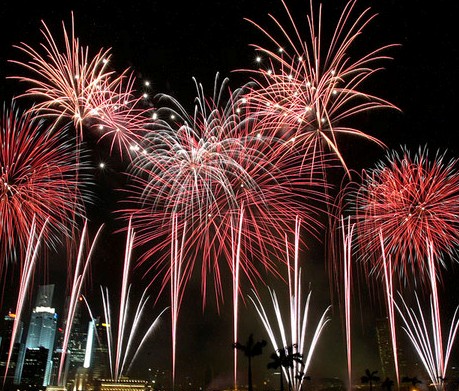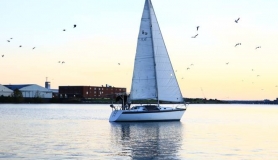The Problem
Fireworks and bonfires emit a nasty cocktail of chemicals, from carbon dioxide and carbon monoxide to sulphur compounds and metal oxides, all of which can affect local air quality and our health.
14% of the UK’s annual dioxin emissions happen on and around 5th November each year. Although dioxins are found everywhere – in our water, soil and atmosphere – high concentrations have been linked to cancer, decreased fertility, diabetes and behavioural problems. Particulates are also released in small amounts and can irritate the eyes, nose and throat as well as penetrating lung tissue and thus causing problems for those with asthma or heart problems. The main problem is that we all want to have a bonfire and a fireworks display on the same night each year. This causes a concentration of all these chemicals in the environment.
A Natural Alternative
Like so many British celebrations, most of us give the original meaning of Guy Fawkes night only a fleeting thought each year. Many bonfire celebrations don’t burn a guy anymore, and this isn’t necessarily a bad thing when you consider the violent undertones. We’ve reinvented the 5th November as a celebration of light and colour, so why not reinvent it again as an environmentally-sound celebration of nature during autumn?
In 2005, Willsbridge Mill, a nature reserve in South Gloucestershire, decided to do just that and cut out the chemicals altogether. They organised an alternative bonfire night event called Nature’s Fireworks Wonders. ‘We wanted to get away from the pollution and celebrate autumnal colours with people who wouldn’t normally visit nature reserves,’ explains Ruth Worsley, a member of staff at Willsbridge Mill.
Children from local primary schools created eight different sculptures in the shape of fireworks. Each was made from natural materials such as dogswood, willow and autumnal leaves. They included traditional bonfire night colours which are also found in abundance in nature during autumn – bright oranges, yellows and reds.
On 5th November, the public were given free tours of the eight sculptures. They learnt about habitats for wildlife on the way and children were given the opportunity to carve images of wildlife into pumpkins and make charcoal drawings on large banners which were later unfurled from the top of a corn mill tower.
In the evening everyone took part in a fireworks display with a difference: ‘We covered acetates in brightly coloured cellophane and put them onto OHPs in front of the mill building,’ explains Ruth. By moving the acetates around we made the shapes and colours produced look a lot like fireworks. At the same time, children in the crowd made firework like noises with ‘light sparklers’ – pieces of scrap metal.’ The event ended with poetry readings by children.
Green Celebrations
There are several ways in which you can celebrate a greener bonfire night:
1) Attend an organised event. The Environment Agency recommends organised events because they will invariably produce less pollution than if everyone attending them held their own event. They will usually have spectacular fireworks displays and sometimes there won’t even be a bonfire, which is good for the environment, as it is bonfires, not fireworks, which release most of the dioxins. Check your local press for details of council or charity run events.
2) Create Community. If, on the other hand, large crowds and flashy firework displays aren’t really your style, another way of cutting down on pollution is to host one event for your whole street. You’ll be helping to build community where you live and you might also be preventing disputes with neighbours. Although there are no laws in the UK preventing people from lighting bonfires on domestic property, councils receives tens of thousands of complaints each year from neighbours annoyed by smoke from bonfires. They recommend that the easiest way to help ease this situation is to warn people what you’re going to be doing well in advance and what better way of telling them than inviting them to join in the fun!
3) Work with Nature. Why not copy Willsbridge Mill and work with nature rather than polluting it? Abandon the environmentally damaging aspects of a traditional bonfire celebration, but retain the best part: the opportunity to be outdoors in the fresh air exploring nature, at a time of year when we spend much of our time indoors hiding from the winter weather. Why not pull on your winter coats and go outside as a family to make colourful sculptures in the garden from plants and natural materials? It might be too late to grow plants for this year, but some of the displays at Willsbridge Mill were made from autumnal leaves, so get those rakes out! Remember to take photographs of your creations. This approach will work especially well if a member of your family has a health problem which is likely to be irritated by a bonfire.
4) Follow the Guidelines. If you are building a bonfire, make sure you follow guidelines on what to burn and how to burn it, to limit the environmental impact. Most local councils recommend the following:
• Only burn dry material. Never burn household rubbish, rubber tyres, or anything containing plastic, foam or paint.
• Never use old engine oil, meths or petrol to light the fire or to encourage it.
• Avoid lighting a fire in unsuitable weather conditions – smoke hangs in the air on damp, still days and in the evening. A fresh, windy day is the better, as the smoke will disperse more easily.
• Avoid burning when air pollution in your area is high or very high. This information is often included in weather forecasts, or you can check by ringing 0800 556677
• Never leave the fire unattended or let it smoulder – douse it with water if necessary.
• Build your bonfire as close to the time you are going to burn it as possible to reduce the chances of small animals climbing inside. Check the bonfire before lighting it for any signs of life.
• Most of the garden material we put on a bonfire would be better disposed of by composting it. However, you can’t compost diseased plant material. If you happen to have any, burning it is actually the best way to get rid of it.
USEFUL INFORMATION
The Environment Agency can advise on what you can and can’t put on a bonfire, to ensure that no toxic chemicals are released. Call their 24 hour helpline on 0800 80 70 60 for advice or see visit: environment-agency.gov.uk.
Local councils have guidelines available on what should and shouldn’t be burned, information on services they provide for alternative ways of disposing of waste and how to avoid annoying your neighbours or to report a disturbance. You can find your local council’s contact details at: directgov.co.uk.
Willsbridge Mill is a restored 19th Century Corn Mill set in a 22 acre nature reserve in South Gloucestershire and maintained by Avon Wildlife Trust. There are walking trails and events and school tours are held regularly. Visit: forestofavon.org.uk or call 0117 932 6885 for more information.







